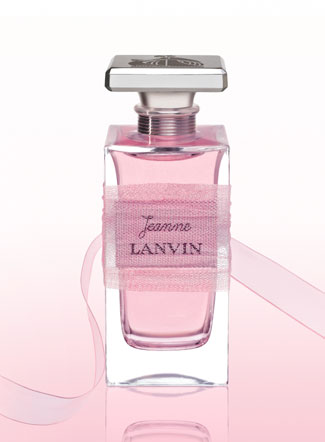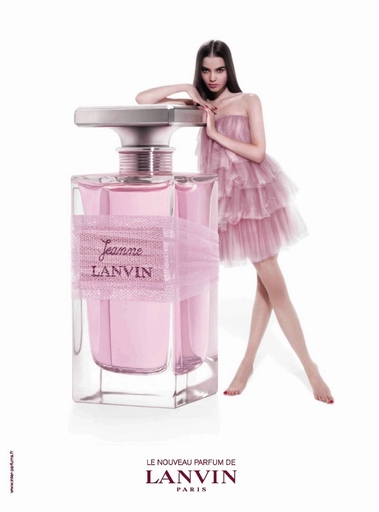Lanvin Jeanne (2008) and Jeanne La Rose (2010): Part 1 - The Scent of High Fashion, Suavissime Soap and Back {Perfume Reviews} {New Fragrance}

Jeanne can offer a beautiful, simple connotation as a first name. It is the feminine pendant of "Jean" which like Pierre and Paul are de facto household given names in (Christian) Europe. Jeanne is the name of historical French heroine, Jeanne d'Arc, and evokes for those who have seen the masterpiece, the beautiful cinematography of Dreyer's Protestant-looking 1927 imagery about the saint. It is also the first name in translation of Jane Austen. It is furthermore, to go back to more immediate connections, the first name of couturière Jeanne Lanvin after which the perfume is named and to whom it pays homage in an updated yet faithful mode...

I say these things because it struck me how the name of this 2008 perfume rings simple and fresh. It benefits at the same time from those invisible vibrations of culture which make it feel familiar while being a new, unfamiliar perfume name.
This aspect of the fragrance's personality comes across more clearly with the name of its new incarnation, Jeanne La Rose. It is still simple but becomes more mythical paired with a quintessential symbolic and perfumer's flower. It sounds now like the nickname of a folk hero, Jane The Rose. Finally, I, unconsciously upon smelling the new rose iteration of Jeanne, cannot help but pick up on the semiotics of warring: the war of the roses conducted by Jeanne, or Jehanne to make it sound more medieval, almost English.
There is arguably a discreet war of the roses going on in the aisles of perfumeries in the recent period attempting to woo young women: Jeanne La Rose seems to want to cross swords with Chloe and its vintage-and-young rose note; with Dolce & Gabbana Rose The One also; perhaps even with Parisienne by Yves Saint Laurent although less directly so in terms of its rose tonality. Rose grand-motherly perfumes are back to create a new updated cohort of memories and not let the 19th century take hold. It is a Lanvin thing too. They like to offer a rose flanker when a fragrance fares well: Rumeur thus was soon followed by Rumeur 2 Rose. Roses are perennial favorites in need of attentive tweakings and trimmings to endure as darling aromas.
Jeanne (2008)
Jeanne was launched in 2008 as a perfume visibly meant to rekindle the olfactory youth of the house of Lanvin, continuing the effort led by Eclat d'Arpège and the new Rumeur which was however less debutante-like in its imagery. Jeanne visually plays upon a very different palette of colors and shapes as that of the star reference of the house, Arpège (1927), substituting the opaque black and gold "boule" designed by Armand-Albert Rateau (there existed also a blue version, the famous Lanvin blue) with a transparent, pastel rose and angular flacon drawn by Alber Elbaz from a vintage design of the house. The cap is now silvery but retains the iconic mother-and-daughter logo designed by Paul Iribe. There had already been in 2002 the pale pastel version of Arpège called Eclat d'Arpège co-created by perfumer Karine Dubreuil and artistic director Alber Elbaz who had entered the oldest extant French fashion house in October 2001; it is worth remembering that Lanvin was established in 1885 as a milliner shop, ten years before the Soeurs Callot. Lanvin thanks to Elbaz has been made to feel in anew, glamorous and more of a leading house in matters of tastes (see his jewelry accessories for example which have been copied the world over).
Jeanne eau de parfum was created by perfumer Anne Flipo who has brought to the composition her proven talent for sheer textures and fresh transparencies already demonstrated in several scents by niche label L'Artisan Parfumeur like Mimosa pour Moi, Verte Violette, but also that quintessential springtime perfume La Chasse aux Papillons, as well as the admirable fruity modern eau de cologne Ananas Fizz (she has done more for them, this is just a selection.) Contrary to what common sense might tell you, perfume compositions that flirt with lightness and barely-thereness are difficult to create. One of the reasons might be that in the logical course of a perfumer's training which takes at least a decade to enter its first phase of maturity, learning to fixate a scent, making it more permanent and giving it volume, are necessary skills to master. Retaining those effects while refining the material to the point of making it appear wan is lodged a flight upstairs on the scale of sophistication. How to master the art of presence while cultivating subtlety and evanescence even non-personality and self-effacement (in appearance)? This is what strikes me with Jeanne. It smells very good but its personality is very, almost irritatingly elusive and abstract. It smells perfumey, it smells of perfume, what is this smell? Could it be Jeanne? Yes, again and again. Most people would probably file this perfume away as another wishy-washy fruity-floral but if I am to believe my perception of its aura and the reactions of people who smell it, Jeanne is most definitely very present and has an effect. It is troublant and alluring in a covert manner.
Decomposing the fragrance a little I would say that it appears to be a meeting of influences from the fruity blackberry-skin-musk accord of Mûre et Musc by l'Artisan Parfumeur and the fresh green tea note of Un Thé en Eté from the same house where Anne Flipo has had time to impregnate herself with certain olfactory directions, as well as to significantly contribute to those.
Although the following notes are not listed, I initially was taken in by the association of a well-balanced kumquat/orange-peel top note paired with a dusting of pepper; the latter can in fact be ascribed to the peppery facet of freesia here, which is given as a "note".
Just to make things clear on how abstract contemporary perfumery in fact is, freesia actually needs to be reconstituted from scratch and the aromachemical Linalol/Linalool traditionally adds this touch of flower plus spice which is needed. This note can also be recreated with 2,5,6-triméthyl-2-heptanol which sounds less nice and evocative than freesia and owes the legitimacy of its existence to the desire to replicate natural aromas. In a way then, it is dependent upon a flower like freesia, so let's call it "freesia." But in the case of Jeanne, and due to its abstract aspect, it is a propos in my view to remind ourselves that perfumes are well-crafted illusions to which we can choose to give certain names or not to encompass them better. Maybe it does not smell like freesia really, but freezia, a freesia floating in a parallel universe. Since we don't know what freezia smells like, let's go back to freesia and its purported characteristic smell (in fact there are different freesia smells, at different moments of the day, depending on the varietals too.) All this to show that perfume and smells are a constant process of abstract selection from reality.
The composition is a fruity berry and transparent, aqueous flower construction resting on a less ethereal base of woods (sandalwood) and very light oriental notes of vanilla, musks, and ambergris. The ambery facet seems white, transparent with a touch of syrupiness when you pay closer attention to it. I discern a note of ambrette seed in the final hours of the perfume, which is always efficacious for creating a subtle and elegant skin-hugging effect while reinforcing the fruity aspect of a perfume whenever needed as in this case.
On the face of it, Jeanne could come across as a tepid fruity-floral barely graduated from washing powder - and it is partly that in inspiration - but the very subtle work on the suggestive sweetness, warmth and sensuality of the perfume pays off as you have to realize that with all its barely-thereness, Jeanne is most certainly there and not banal-smelling. It is very subtly yet powerfully diffusive. You step into a room and people say "it" smells good (not "you" smell good). It enters the building before you and seems to wrap you in its perfume-y embrace evoking to me that fascinating leimotiv reported by many witnesses: the perfume-y atmosphere of a fashion house (by contrast with the less refined and more jarring cacophony sometimes of a perfumery).
Finally I have to report an interesting cognitive experience that occurred by accident. I was leafing through some pages of Le sillages des élégantes by Marylène Delbourg-Delphis when my gaze alighted on a vintage advertisement of Arpège by Lanvin where a little girl is plotting a mother's day gift. Right there and then, as I was wearing Jeanne, I could suddenly smell the Arpège accord in it, carefully ensconced in its 2008 pink tulle frills. Underneath the berries and the powdery white musks, there is the sweet ambery glow and overripe alcoholic flowers of Arpège. I repeated the experiment and it happened again: I could perceive the seamless relationship of identity expressing itself between the featured bottle of Arpège, my memory of the scent which I wore for several years (with rest periods), and the current perception of Jeanne. Arpège is here, but well-hidden yet supportive. Arpège was so successful it has been copied in soaps and detergents across the globe. When we say that something smells soapy and like washing powder, we really need to keep in mind those fluid commutes existing between fine perfumery and functional perfumery. Camay is an Arpège type just like Jeanne is a bit of a soapy type of scent and lingering luxurious lingerie scent exuding from the cabins of a fashion house.
As we enter a period of perfumery creations led by the concept of soap, we will have occasion to return to those interesting commutes.
Opening notes: cedrat, blackberry, pear nectar
Sustained notes: pink peony, raspberry, crystallized rose, freesia
Lingering notes: white musks, sandalwood, ambergris
Next up, Jeanne La Rose (2010)










Thank you for an intriguing description of this fragrance. Just ordered some to try and I appreciate your thoughts.